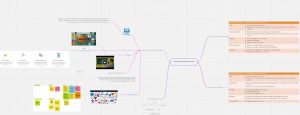
O Online Learning, Parting Was NOT Sweet Sorrow
This week’s topic – tools for distance and online learning – strikes a personal cord. Memories of my last 2.5 years as an online learning consultant cause an odd mixture of melancholy, anxiety, aversion, and pride to roll through my chest. Anyone in education over the last 3 years might feel a similar twinge. Love it or lump it, the need for distance and online learning -exacerbated by the pandemic – caused a shift in digital EdTech that will be studied for decades. (Am I being too dramatic if I say centuries?)
In Tyler Dewitt’s TedX Talk, he notes the inevitable push/pull factors of online learning and digital tools, but concludes with a quote from his father:
“The focus of education should be learning, not teaching.”
Similarly, the purpose of distance and online learning tools should be to incite authentic learning opportunities for students. From my ISTE training and the last few years online, I have learned that relevant/purposeful EdTech tools are more than just the “flavour of the month” or novelty items. Digital tools require careful consideration of sheltered instruction, cultural responsibility, graphic design, and accessibility.

Indiana University’s Teaching Online MOOC
My Tickle Trunk of Online Tools
Using Miro, my favourite collaborative online whiteboard (for staff and students), I have outlined my gold-star, most-used online tools over the last few years. While I use and appreciate many of the tools discussed in class and noted in the suggested readings, I tried to include a few lesser-known tools that also hit ISTE online standards. Many of these tools were Godsends while working online, and now that I have moved back to the classroom, remain relevant learning tools for students.

Click to interact with Miro Mindmap
- Edsby: As more Saskatchewan divisions shift toward Edsby, I have the unique vantage point (for better or worse) of being the Edsby SK “guinea pig.” When the pandemic hit, my division accelerated its Edsby implementation and I have spent the last few years training teachers and students to utilize Edsby as our division’s main lesson, assessment, and communication hub. Edsby is not without its faults, scoring particularly low in ISTE standards for accessibility; however, it remains relevant as a multi-purpose learning centre.
- Back in the classroom: Edsby continues to be my main source for student/family communication, secure online student learning portfolios and chats, lesson planning, and resource/link sharing. I’ve become so accustomed to Edsby, I’m not sure how I’d work in a classroom without it now (and yes, I see the danger in that sentiment).
- Peardeck: I was pleased to see Peardeck mentioned in Prodigy’s The 20 Best Tools for Virtual and Distance Learning. Used as a cloud-based Google Slides add-on, Peardeck seamlessly transforms or creates interactive slides that promote student learning and engagement. Synchronous and asynchronous options like free response questions and drawing grids allow for streamlined, individualized formative assessment.
- Back in the classroom: The asynchronous features were highly beneficial when online teaching, and back in the classroom both asynchronous and synchronous options remain relevant. Rather than having one student verbally answer while I present from Google Slides, Peardeck ensures all students can digitally answer. Student answers can be identified on the teacher dashboard, and then highlighted for further classroom discussions and/or conferring.
- Mathigon: With an interactive polypad filled to the brim with math manipulatives, Mathigon allows all online students to interact with math. Online math assessments can lead to accessibility issues and 2-dimensional thinking; however, Mathigon provides equal access, and opportunities for authentic and collaborative numeracy engagement.
- Back in the classroom: While my current placement allows for privileged access to 1-1 computers and a plethora of math resources, my students enjoy the creativity and experimentation Mathigon provides for their numeracy tasks. In-school students who need to complete homework are able to use Mathigon to continue their learning and collaboration outside of school hours.
Honourable Mention
- Google. Period.
- Google Jams, Slides, Forms, Docs are the most highly used tools I have used online or in the classroom. A majority of Google’s “arsenal” comes with assistive technology functions (ex: text-to-speech and proofreading) that allow diverse learners to gain confidence and independence. Disclaimer: 😉 I am not affiliated with or endorsed by Google; I just think they’ve done some amazing work.
One Caveat…Ah, there’s the rub!
All of these online tools – mentioned here and elsewhere – can be extremely beneficial to student learning when students have equitable access. My quick shift to online quickly highlighted that the digital divide in Saskatchewan (let alone the rest of the world) is alive, well, and growing! Inequitable access does not negate the beneficial aspects of many of these tools, but these unfortunate realities cannot be ignored either. We must always ask who is being served by these online platforms and tools. The companies and shareholders? As discussed in class, EdTech companies appear the clear winners, often at the cost of our digital privacy. Students in emergent nations with privileged digital access equally benefit from these technologies. Until we can say that all students benefit from the plethora of distance and online tools, our work as educators and compassionate citizens remains unfinished.
Despite learning a great deal while working online, I will not be writing any Shakespearean odes to it either. Experience tells me I can shift from classroom to online to classroom with general ease. My desire to do so again remains doubtful. While I often deep-dive into the latest digital possibilities, I’m certain nothing can replace the human connection found between teachers and students learning together.
Points to Ponder
- Do you have any lesser-known favourite online tools to recommend (that have not already been mentioned)?
- How do you identify/separate purposeful EdTech from more “flash in the pan” options?
- As noted by Neil Postman, who do you believe are the “clear winners and losers” in EdTech? Who is not being served by these digital offerings?
Hi Kim. As a high school math person one of my go to apps is Desmos graphing calculator. Like most schools we have caddies full of Texas Instruments graphing calculators (circa 1999). While they are quite useful (particularly for statistics – calculating standard deviation for large data sets makes me shudder), the interface is akin to flying the space capsule from a Saturn series rocket. Memorizing button presses and sub menus is unintuitive and painful for students, and because the darn things still cost well over 100 dollars we can’t allow them to take them home (because we can’t afford to replace them). Contrast this was the modern design of an app constructed for touch screens and mobile devices and its a night and day difference. Need to find where two graphs intersect one another? Simply mash your finger on the spot and the coordinates will appear – contrast this to using the trace function on a TI-83/84 series and its like trying to teach the children arcane sorcery. We’ve come along way, and although this isn’t a lesser known app (it is one of the titans of mathematics), it is an essential app for anyone tasked with teaching a senior mathematics class.
Hi Matt,
Now that you say that about Desmos – I have heard it recommended numerous times, and always fail to check it out. Just went through it before responding, and it definitely seems like a worthwhile mathematics app. Thanks for the (re)recommendation.
Great post, Kim!
I took an ed tech class over the winter and I was partnered up with a colleague who works at inner city school. We have vastly different experiences with using technology. I teach at a predominantly white, middle-class school. We have four sets of chrome books and a class set of iPads. With the senior kids, we don’t even need to access them because most of the students have their own devices they bring to school. They are competent and digitally literate, so we are able to foster a collaborative environment that is independent and student led.
My colleagues experience is quite different coming from a lower SES. Most students don’t have access to technology outside of class, and due to lower academics overall, the students are not independent enough to work on technology without direct instruction from the teacher.
It would seem then that the students from my school have more enriching experiences with tech and are able to immerse themselves into more complex learning, which ultimately leaves the lower SES students behind. Is it even possible to mitigate this? What does this mean for the future of students who move into the work force? One seemingly has a leg up due to their backgrounds and experiences.
Hi Gilbert,
Thanks for the thoughtful response – you really showcase why I think educator awareness about EdTech/the digital divide is so important. Before the pandemic, I had worked at a community school for 10 years, and my experience was similar to your colleagues. I spent 2 years being an online consultant – seeing the gamut of tech access and ability. Now, I am at a – dare I say – highly privileged school in my community, and accessibility and student ability vary greatly from my previous experience. I am so grateful for this awareness, and these types of conversations need to continue to happen between colleagues/schools/divisions to provoke improvements in our communities.